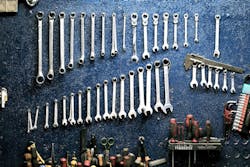Collision repair can be risky business, given all the equipment and tools required for the job. Consider: in 2018, there were 26 deaths among automotive technicians related to contact with objects and equipment, according to the Bureau of Labor Statistics.
By and large, such deaths are preventable, if repair facilities properly test and maintain their vehicle lifts.
In late 2019, FenderBender reported on a pair of fatal lift accidents within two months of one another. In both cases, a vehicle fell off a lift and onto an employee. And, while the most important thing is to make sure your employees are safe and accidents like these don’t happen, there are also hefty fines involved when lifts aren’t up to code. According to Emergency Health Safety (EHS) Today, OSHA safety violations increased in 2019; the fines can be anywhere between $13,260 to upward of $132,598 for repeated or willful safety violations.
Fortunately, body shops can avoid fines and putting employees at risk by following these steps.
Buy a Certified Lift
Back in 2018, Automotive Lift Institute (ALI) warned shops of counterfeit lift inspection labels after multiple were found throughout New York City and Long Island, N.Y. On top of these fake inspection labels, ALI President, R.W. (Bob) O’Gorman says the CE certification marking—found on all European-made products that meet the health, safety, and environmental standards under the European Union (EU)—doesn’t alone qualify as a certified and inspected lift under the International Building Code (IBC) in the U.S.
When purchasing a lift, O’Gorman says the label to look for is the Automotive Lift Institute’s Gold Label. Without ALI’s gold label, the shop has no evidence that the lift has been third-party tested and proven to meet the safety and performance requirements of ANSI/ALI ALCTV—this is what O’Gorman calls “buyer beware.”
“Without ALI’s gold label, there’s no way that your lift will be up to standards with IBC [International Business Code],” O’Gorman says.
If it’s not up to these standards, shop owners risk hefty fines and endangering their employees.
Inspect Annually
OSHA’s General Duty Clause requires employers to provide a workplace free of recognized hazards that could cause death or serious physical harm. It all starts with getting lifts inspected a minimum of once per year by a qualified lift inspector, which ALI says operators can find by contacting their lift’s manufacturer, or even looking one up at autolift.org.
When assessing fines, O’Gorman says there are three categories of citations: operation, inspection, and maintenance. First, occupational safety and health officials will make sure the operator is properly trained; second, they will check if the lift was inspected within one year; and third, they will see if the shop has a planned maintenance schedule, which the shop will have to provide proof of.
Practice Proper Lift Procedures
For starters, O’Gorman stresses the importance of staff members becoming familiar with the vehicle lift manufacturer’s recommendations. But, with every lift, some practices are universal. Here are the safety steps provided by ALI for all operators to follow:
1) Prep the area.
Before beginning, make sure to prepare a bay by making sure the lift area is free of grease and oil, tools, hoses, trash, and other debris.
2) Position the vehicle correctly.
If using a two-post or other frame-engaging lift, start by positioning supports or adapters to contact the vehicle manufacturer’s recommended lifting points. According to O’Gorman, not using the proper lifting points is a common mistake that operators make, and it can result in the vehicle being unstable.
3) Place the vehicle on lift.
Next, raise the lift until the supports or adapters contact the vehicle securely, and check the lifting points again, raising the vehicle until the tires clear the floor. Shake the vehicle to confirm stability. After a final visual confirmation, raise the lift to desired working height and lower the lift onto its load-holding devices. Visually check all vehicle contact points once more to make sure each adapter or support is securely in position before going under the vehicle.
4) Remove the lift properly.
Before releasing the load-holding device to lower the lift, remove tool boxes, jacks, oil drain systems, and anything else from under the lift. And when you’re done, operating controls should be returned to the neutral, or off, position when released.



